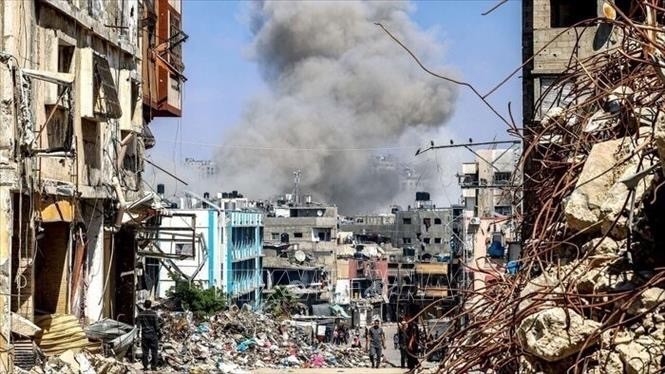(VOVWORLD) - One year after the conflict between Israel and Hamas erupted in Gaza, the toll has been devastating, and the violence has spread beyond Gaza's borders, further dividing the world and destabilizing the entire Middle East.
 One year of Gaza conflict: parties trapped in a worst-case scenario One year of Gaza conflict: parties trapped in a worst-case scenario |
On October 7 last year, Hamas launched a surprise attack on southern Israel, killing over 1,100 Israeli soldiers and civilians, and taking more than 250 hostages. In retaliation, Israel initiated a full-scale assault against Gaza, plunging the region into a cycle of violence that has only intensified.
Catastrophic consequences
According to UN data released on October 6, just before the first anniversary of the conflict, nearly 42,000 Palestinian civilians—most of them women and children—have been killed in Gaza, and 100,000 have been injured. Almost the entire population of Gaza, roughly 2.3 million people, has been displaced, while 80% of Gaza’s infrastructure lies in ruins. The destruction has knocked out essential services like schools, hospitals, and sanitation systems, and 42 million tons of debris—14 times the previous 15 years’ total—has piled up across Gaza. Persistent fighting and obstacles to relief efforts have placed millions at risk of famine.
International organizations, including the Office of the High Commissioner for Human Rights (OHCHR), the World Health Organization (WHO), and the World Food Program (WFP), have condemned the humanitarian crisis in Gaza. The large number of civilian casualties and violations of international law have drawn severe criticism. UN Secretary-General António Guterres, in his message marking the 1st anniversary of the conflict, urged an immediate end to the conflict.
While Gaza has borne the brunt of the devastation, Israel too has suffered significant losses. More than 1,200 Israelis have been killed, and nearly 10,000 wounded and Israel’s economy has been severely damaged. The Bank of Israel estimates that if the conflict drags on through next year, it could cost 66 billion USD—12% or more of Israel’s GDP—making this the costliest conflict in Israel’s history. The International Monetary Fund has revised Israel’s growth forecast downward to 1-1.9%, just a third of previous projections.
The conflict is expanding
What began in Gaza has now spread, and fears of a full-scale regional war are becoming a reality. The fighting has reached Lebanon, where Israeli forces have ramped up airstrikes and ground offensives aimed at Hezbollah, a key Hamas ally. The violence has displaced roughly 1 million Lebanese in the last two weeks, and the situation is growing more volatile. Israel and Iran—the two biggest regional military powers—have exchanged direct airstrikes, crossing red lines that could draw other nations into the conflict.
Karima Laachir, Director of the Center for Arab and Islamic Studies at the Australian National University, described the escalating violence as evidence of the impotence of the international community, especially the UN, and the failure of policies on all sides, particularly those of Israel and its Western allies. She stressed the urgent need for all parties to radically rethink long-term security solutions before the situation becomes irreparable.
Elie Barnavi, former Israeli Ambassador to France, said that a year after the Gaza conflict began, Israel’s security has not improved despite ongoing military campaigns. Instead, the situation has worsened, with the country now contending with threats on seven different fronts: Hamas in Gaza, Hezbollah in Lebanon, the Intifada movement in the West Bank, Houthi forces in Yemen, militias in Iraq, militias in Syria, and Iran. Given this reality, Barnavi said, a diplomatic solution—starting with a ceasefire and the return of hostages in Gaza—is the only viable path to prevent an even greater conflict for all involved parties